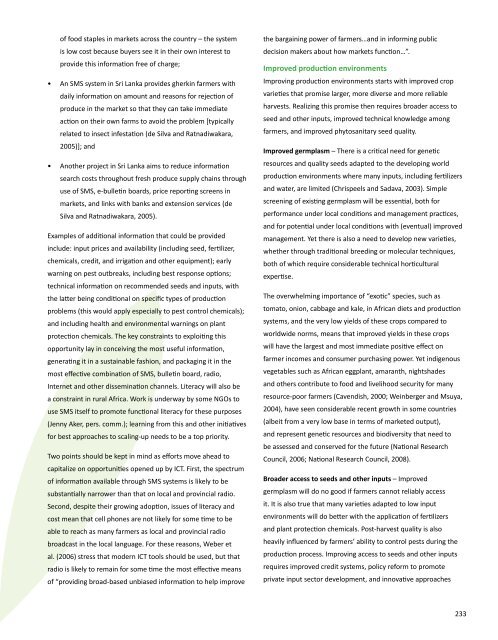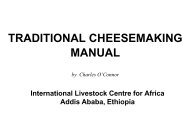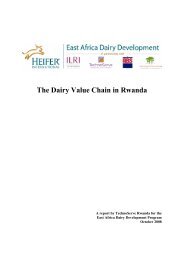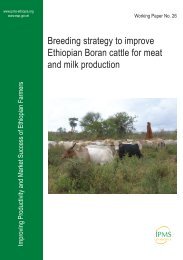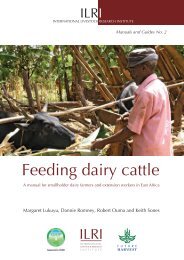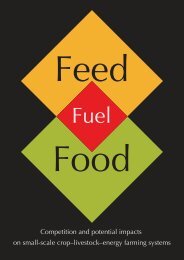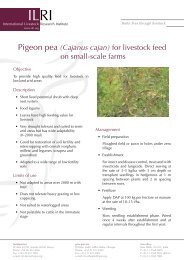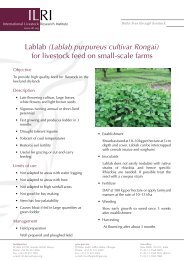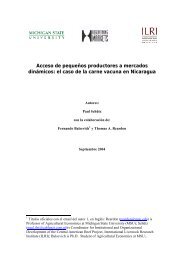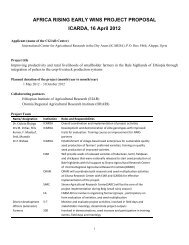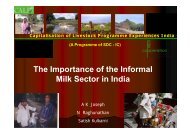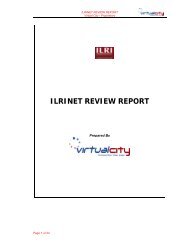High-Value Commodities and Agroprocessing - International ...
High-Value Commodities and Agroprocessing - International ...
High-Value Commodities and Agroprocessing - International ...
Create successful ePaper yourself
Turn your PDF publications into a flip-book with our unique Google optimized e-Paper software.
of food staples in markets across the country – the system<br />
is low cost because buyers see it in their own interest to<br />
provide this information free of charge;<br />
• An SMS system in Sri Lanka provides gherkin farmers with<br />
daily information on amount <strong>and</strong> reasons for rejection of<br />
produce in the market so that they can take immediate<br />
action on their own farms to avoid the problem [typically<br />
related to insect infestation (de Silva <strong>and</strong> Ratnadiwakara,<br />
2005)]; <strong>and</strong><br />
• Another project in Sri Lanka aims to reduce information<br />
search costs throughout fresh produce supply chains through<br />
use of SMS, e-bulletin boards, price reporting screens in<br />
markets, <strong>and</strong> links with banks <strong>and</strong> extension services (de<br />
Silva <strong>and</strong> Ratnadiwakara, 2005).<br />
Examples of additional information that could be provided<br />
include: input prices <strong>and</strong> availability (including seed, fertilizer,<br />
chemicals, credit, <strong>and</strong> irrigation <strong>and</strong> other equipment); early<br />
warning on pest outbreaks, including best response options;<br />
technical information on recommended seeds <strong>and</strong> inputs, with<br />
the latter being conditional on specific types of production<br />
problems (this would apply especially to pest control chemicals);<br />
<strong>and</strong> including health <strong>and</strong> environmental warnings on plant<br />
protection chemicals. The key constraints to exploiting this<br />
opportunity lay in conceiving the most useful information,<br />
generating it in a sustainable fashion, <strong>and</strong> packaging it in the<br />
most effective combination of SMS, bulletin board, radio,<br />
Internet <strong>and</strong> other dissemination channels. Literacy will also be<br />
a constraint in rural Africa. Work is underway by some NGOs to<br />
use SMS itself to promote functional literacy for these purposes<br />
(Jenny Aker, pers. comm.); learning from this <strong>and</strong> other initiatives<br />
for best approaches to scaling-up needs to be a top priority.<br />
Two points should be kept in mind as efforts move ahead to<br />
capitalize on opportunities opened up by ICT. First, the spectrum<br />
of information available through SMS systems is likely to be<br />
substantially narrower than that on local <strong>and</strong> provincial radio.<br />
Second, despite their growing adoption, issues of literacy <strong>and</strong><br />
cost mean that cell phones are not likely for some time to be<br />
able to reach as many farmers as local <strong>and</strong> provincial radio<br />
broadcast in the local language. For these reasons, Weber et<br />
al. (2006) stress that modern ICT tools should be used, but that<br />
radio is likely to remain for some time the most effective means<br />
of “providing broad-based unbiased information to help improve<br />
the bargaining power of farmers…<strong>and</strong> in informing public<br />
decision makers about how markets function…”.<br />
Improved production environments<br />
Improving production environments starts with improved crop<br />
varieties that promise larger, more diverse <strong>and</strong> more reliable<br />
harvests. Realizing this promise then requires broader access to<br />
seed <strong>and</strong> other inputs, improved technical knowledge among<br />
farmers, <strong>and</strong> improved phytosanitary seed quality.<br />
Improved germplasm – There is a critical need for genetic<br />
resources <strong>and</strong> quality seeds adapted to the developing world<br />
production environments where many inputs, including fertilizers<br />
<strong>and</strong> water, are limited (Chrispeels <strong>and</strong> Sadava, 2003). Simple<br />
screening of existing germplasm will be essential, both for<br />
performance under local conditions <strong>and</strong> management practices,<br />
<strong>and</strong> for potential under local conditions with (eventual) improved<br />
management. Yet there is also a need to develop new varieties,<br />
whether through traditional breeding or molecular techniques,<br />
both of which require considerable technical horticultural<br />
expertise.<br />
The overwhelming importance of “exotic” species, such as<br />
tomato, onion, cabbage <strong>and</strong> kale, in African diets <strong>and</strong> production<br />
systems, <strong>and</strong> the very low yields of these crops compared to<br />
worldwide norms, means that improved yields in these crops<br />
will have the largest <strong>and</strong> most immediate positive effect on<br />
farmer incomes <strong>and</strong> consumer purchasing power. Yet indigenous<br />
vegetables such as African eggplant, amaranth, nightshades<br />
<strong>and</strong> others contribute to food <strong>and</strong> livelihood security for many<br />
resource-poor farmers (Cavendish, 2000; Weinberger <strong>and</strong> Msuya,<br />
2004), have seen considerable recent growth in some countries<br />
(albeit from a very low base in terms of marketed output),<br />
<strong>and</strong> represent genetic resources <strong>and</strong> biodiversity that need to<br />
be assessed <strong>and</strong> conserved for the future (National Research<br />
Council, 2006; National Research Council, 2008).<br />
Broader access to seeds <strong>and</strong> other inputs – Improved<br />
germplasm will do no good if farmers cannot reliably access<br />
it. It is also true that many varieties adapted to low input<br />
environments will do better with the application of fertilizers<br />
<strong>and</strong> plant protection chemicals. Post-harvest quality is also<br />
heavily influenced by farmers’ ability to control pests during the<br />
production process. Improving access to seeds <strong>and</strong> other inputs<br />
requires improved credit systems, policy reform to promote<br />
private input sector development, <strong>and</strong> innovative approaches<br />
233


